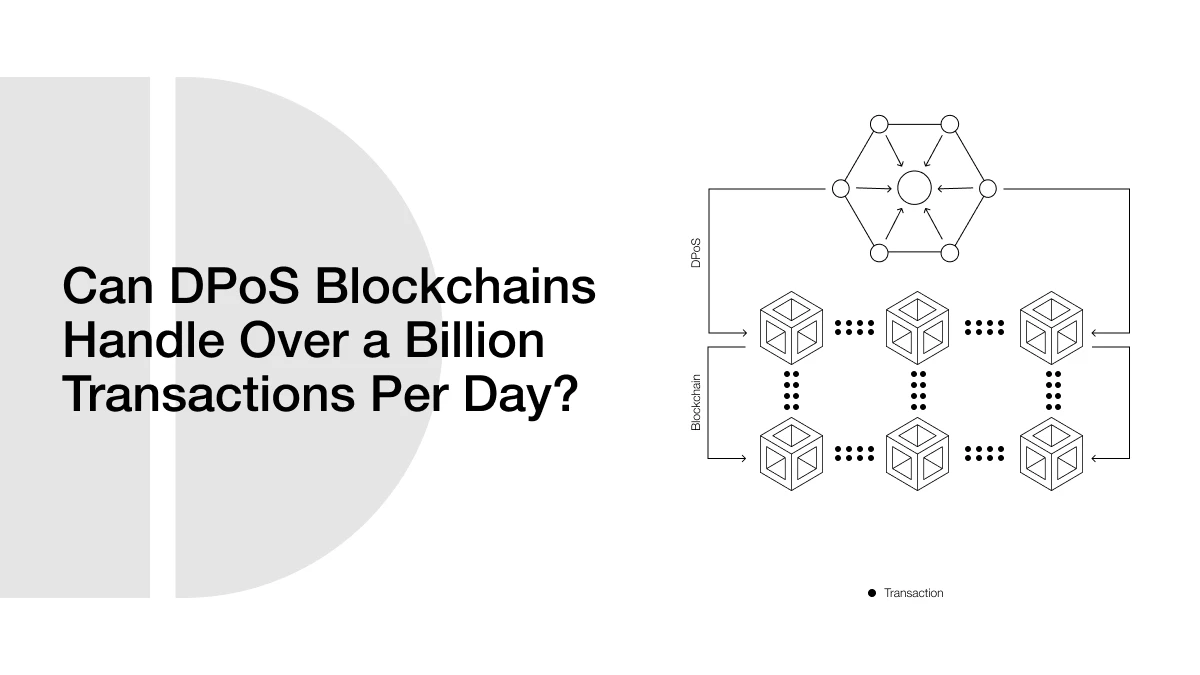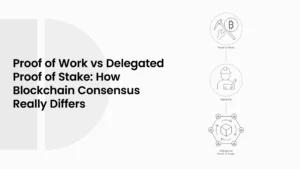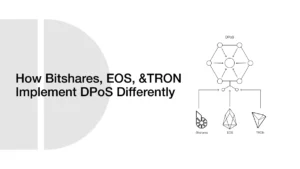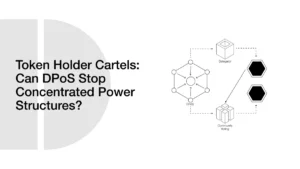Can DPoS Blockchains Handle Over a Billion Transactions Per Day?

Blockchains need to do more than just secure data; they need to do it fast, often at a massive scale. As millions of individuals apply blockchain apps to finance, games, social media, and even supply chains, the issue of the big question is: Will those networks be able to scale?
- What Is DPoS?
- Why It Was Created
- How It Differs from PoW and PoS
- How DPoS Works (Step-by-Step for Beginners)
- Voting and Delegation Process
- How Block Producers Are Chosen
- How Transactions Are Approved
- Comparing DPoS with Other Systems
- Can DPoS Really Handle Billions of Transactions Daily?
- Key Features That Enable High Scalability
- DPoS TPS Compared to Other Consensus Systems
- What Affects DPoS Transaction Speed?
- Number of Delegates (Block Producers)
- Network Load and Bandwidth
- Delegate Node Performance
- Software Optimization and Code Quality
- DPoS in Action: High-Performance Projects Using It
- EOS: The Original Speed Machine
- TRON: Scaling Web3 Content
- WAX: Built for NFTs and Virtual Goods
- Top DPoS Projects and Their Speed Benchmarks
- Can DPoS Scale Beyond One Billion? The Challenges
- How DPoS Tries to Solve the Blockchain Trilemma
- Decentralization: Community Voting with a Catch
- Security: Fewer Points of Failure, Higher Accountability
- Scalability: The Star Performer
- The Final Word
- Frequently Asked Questions (FAQs)
- Glossary of Key Terms
Enter Delegated Proof of Stake (DPoS). DPoS is fast and energy efficient, which makes it a go-to blockchain system when it comes to scaling. Popular networks such as EOS, TRON, and Hive apply DPoS to enable their fast and stable transactions per second. However, is it possible that this system will be able to exceed a billion transactions per day?
This blog will explain everything. You will find out how DPoS functions, how it can be compared to the other systems, such as Proof of Work (PoW) and Proof of Stake (PoS), and what distinguishes it. And it will also look at real-life examples, technical constraints, and whether a DPoS blockchain can handle billions of transactions per day.
If you’re new to blockchain or just curious about how this technology can scale globally, you’re in the right place. Let’s start by breaking down what DPoS actually is.
What Is DPoS?
Delegated Proof of Stake is a form of blockchain system that assists computers in reaching an agreement for transaction validations. Simply put, it is a voting algorithm where coin owners in the blockchain can go and vote on the trusted people, referred to as delegates or block producers, who will then do the work of validating and confirming transactions on behalf of everyone.
ALSO READ: Can Social Reputation Fix Delegate Elections in DPoS Blockchains?
You can think of it like electing a small team to run the system smoothly instead of having everyone try to do the work at once. This makes things faster and more efficient.
DPoS is fast, environmentally friendly, and more democratic than the earlier systems, such as the Proof of Work in Bitcoin. It provides the community with greater control and keeps the network running fast and securely.
Why It Was Created
DPoS was invented in 2014 by Dan Larimer as a solution to problems found in earlier blockchain models. At the time, Proof of Work (PoW) was the most popular system. It required a lot of energy and computing power to process transactions. This made it slow, expensive, and harmful to the environment.
Then came Proof of Stake (PoS), where people with more coins had more power to approve transactions. It was more efficient than PoW, but still had issues with centralization and voting fairness.
DPoS was designed to fix these problems. It consumes less energy, conducts transactions quickly, and allows common users to vote on who operates the network. It is as though it is going to be changing a room full of people shouting to one or two individuals being voted to represent the whole group, and decisions are made faster and easier.
How It Differs from PoW and PoS
Let’s break it down in the simplest terms:
| Feature | Proof of Work (PoW) | Proof of Stake (PoS) | Delegated Proof of Stake (DPoS) |
| Who approves blocks? | Miners with powerful computers | Anyone with staked coins | Elected delegates |
| Speed | Slow (minutes per block) | Medium (depends on network) | Fast (seconds per block) |
| Energy usage | Very high | Low | Very low |
| Governance style | None | Token-based voting | Voting for delegates |
| Decentralization | High, but inefficient | Medium | Medium to High (depends on voter base) |
| Main issue | Energy waste and slow speed | Risk of big holders controlling too much | Risk of delegate collusion |
DPoS is unique because it is fast, efficient, and community-controlled. It is not ideal, yet it is a significant step to make blockchain scale to a much larger extent, potentially supporting billions of transactions every day.
How DPoS Works (Step-by-Step for Beginners)
Voting and Delegation Process
At the heart of Delegated Proof of Stake is voting. But don’t worry, it’s not like voting in a national election. It’s all digital, and your vote is based on how many coins or tokens you hold.
Here’s how it works:
- Everyone who holds the network’s cryptocurrency gets a vote.
- Instead of validating blocks themselves, users vote for delegates (also called block producers or witnesses).
- These delegates are trusted to add new blocks and confirm transactions.
- You can change your vote at any time. If a delegate misbehaves or fails to perform their duties, voters can replace them.
This keeps the network flexible and community-driven, while still being efficient.
How Block Producers Are Chosen
The delegates with the most votes get selected to produce blocks. The number of active delegates is 21 to 101 in most DPoS systems. This small team is useful in making decisions without delays, unlike in older systems.
It works like this:
- Token holders vote using their coins.
- The top-voted delegates become block producers.
- They take turns, following a fixed schedule, to create and sign new blocks.
Because there are fewer producers and they already know the order in which they’ll act, the system avoids the delays and randomness of older blockchain models.
ALSO READ: 6 Mistakes New DPoS Stakers Make (And How to Avoid Them in 2025)
How Transactions Are Approved
Once a delegate’s turn comes up:
- They collect valid transactions from the network.
- These are bundled into a new block.
- The block is signed and broadcast to the rest of the network.
- Other delegates quickly confirm it.
- Once a majority agrees, the block is added to the chain.
This process can happen in just a few seconds, depending on the project.
Comparing DPoS with Other Systems
| Feature | Proof of Work (PoW) | Proof of Stake (PoS) | Delegated Proof of Stake (DPoS) |
| Who validates blocks? | Miners (based on computing) | Token holders (via staking) | Voted delegates |
| Transaction speed | Slow (10+ minutes/block) | Medium (1–10 mins/block) | Fast (1–3 seconds/block) |
| Energy use | Very high | Low | Very low |
| Scalability | Limited | Moderate | High |
| Participation required | None beyond miners | Anyone can stake tokens | Anyone can vote for delegates |
| Decentralization risk | Lower, but inefficient | Depends on token distribution | Risk of delegate collusion |
Can DPoS Really Handle Billions of Transactions Daily?
The short answer? Yes, but with conditions.
Many DPoS-based blockchains are already capable of processing thousands of transactions per second (TPS). When you do the math, even 10,000 TPS translates to 864 million transactions per day. Some networks, with the right hardware and optimization, claim they can push this number above a billion.
Let’s look at the key reasons why this is possible and where the limits might be.
| Blockchain | Consensus | Claimed TPS | Real Use Cases |
| EOS | DPoS | 4,000+ | dApps, DeFi, gaming |
| TRON | DPoS | 2,000+ | Media sharing, Web3 platforms |
| Telos | DPoS (EOSIO) | 10,000+ | Governance tools, enterprise applications |
| WAX | DPoS | 8,000+ | NFTs, a virtual goods marketplace |
| Aelf | DPoS | 15,000+ | Cross-chain computation, enterprise use |
In some internal tests (not public benchmarks), DPoS chains have demonstrated performance of nearly 20,000 TPS, which is equivalent to more than 1.7 billion transactions per day.
Key Features That Enable High Scalability
So how does DPoS make this happen? Here’s a breakdown of what gives DPoS its super-speed:
1. Limited Number of Block Producers
Unlike PoW or PoS, where thousands of nodes may need to communicate and validate, DPoS narrows it down to a few dozen trusted delegates. That removes delays.
2. Pre-Scheduled Block Production
Each delegate knows exactly when it’s their turn. No waiting, no randomness. This helps avoid wasted time and cuts block production to just a few seconds.
3. Lightweight Consensus
Since only a small set of nodes need to agree, the consensus process is much faster. There’s no mining race or lottery involved.
4. Parallel Execution and Multi-Threading
Some advanced DPoS chains (like Aelf and Telos) use parallel processing, which means they can handle different parts of the network at the same time, similar to how your computer opens multiple tabs at once.
DPoS TPS Compared to Other Consensus Systems
| Consensus Type | Typical TPS Range | Energy Usage | Scalability Rating |
| Proof of Work (PoW) | 3–15 TPS | Very high | Low |
| Proof of Stake (PoS) | 50–300 TPS | Moderate | Moderate |
| Delegated Proof of Stake (DPoS) | 2,000–20,000+ TPS | Very low | High |
Such capacity means that DPoS is one of the few consensus systems that might practically handle billion-scale daily transaction volumes, at least in global applications such as Web3 social networks, metaverse platforms, or enterprise blockchains.
What Affects DPoS Transaction Speed?
Although the speed is one of the characteristics of DPoS, not every DPoS blockchain is equally speedy. Similar to the speed of the car and the road, the engine, and the ability of the driver, DPoS networks require a lot of dependency. What are some of the most important factors that may influence the speed (or rather, slowness) of such systems?
Number of Delegates (Block Producers)
The fewer the delegates, the quicker the decision-making process, but it might be at the expense of decentralization. The majority of DPoS systems select between 21 and 101 active delegates. By adding too many delegates, it may make the network more democratic, but it may also slow down, as the communication overhead will increase.
Ideal setup: Around 21–51 high-performance nodes for a balance between speed and decentralization.
ALSO READ: How to Build a Custom DPoS Chain Using Cosmos SDK
Network Load and Bandwidth
Even if a blockchain is fast, it still depends on the internet infrastructure. If too many users flood the network with transactions at once (like on NFT launch days), this could cause:
- Delays in block production
- Failed or delayed transactions
- Higher transaction fees
To handle a billion transactions a day, the network must support high data throughput, meaning all delegates and nodes need to have strong internet connections and data-handling capacity.
Delegate Node Performance
The computers (or servers) that delegates use must be powerful and well-optimized. Weak or overloaded nodes may miss their turn, delay the block production schedule, or fail to validate transactions.
Common requirements include:
| Minimum Node Specs | Purpose |
| 8–16 CPU cores | Multi-threaded processing |
| 32–128 GB RAM | In-memory transaction handling |
| SSD Storage | Faster read/write for blocks |
| 1 Gbps Internet Speed | Low-latency data transmission |
Software Optimization and Code Quality
Even if the system is built on DPoS, the underlying blockchain code matters. Clean, optimized code ensures:
- Blocks are processed quickly
- Delegates don’t crash under load
- Smart contracts run efficiently
- The memory and storage are used wisely
Projects like EOSIO and Aelf invest heavily in custom virtual machines and multithreading logic to push their performance to the edge.
DPoS in Action: High-Performance Projects Using It
To comprehend how strong DPoS can be, let’s examine the blockchains that have already been adopted to real-life conditions and apply the system. These platforms demonstrate that DPoS is not only a theory but a tested instrument to manage a huge number of transactions.
EOS: The Original Speed Machine
EOS was one of the first blockchains to showcase the capabilities of DPoS. Launched in 2018, EOS aimed to support decentralized apps (dApps) with low fees and ultra-fast confirmation times.
- Block time: 0.5 seconds
- Delegates (Block Producers): 21
- Claimed TPS: Over 4,000
- Real Use Cases: Games, DeFi, social platforms, developer tools
EOS uses a tight rotation schedule for delegates, ensuring fast, predictable performance. It’s still a prime example of high-speed DPoS.
TRON: Scaling Web3 Content
TRON adopted DPoS to power its entertainment and content-sharing ecosystem. The focus is on global reach, high throughput, and supporting features such as live streaming, social media, and games.
- Block time: 3 seconds
- Delegates (Super Representatives): 27
- Claimed TPS: 2,000+
- Real Use Cases: Audius (Web3 Spotify), BitTorrent Chain, NFT platforms
TRON’s fast finality and support for millions of users show how DPoS can support heavy-duty consumer apps.
WAX: Built for NFTs and Virtual Goods
WAX (Worldwide Asset eXchange) is a purpose-built blockchain using DPoS to enable fast, cheap trading of NFTs and digital items.
- Block time: 0.5 seconds
- Delegates: 21
- Claimed TPS: Up to 8,000
- Real Use Cases: Virtual collectibles, Web3 gaming, NFT drops
Because NFT drops often see huge traffic spikes, WAX is designed to absorb massive surges, proving DPoS can handle real-world stress.
Top DPoS Projects and Their Speed Benchmarks
| Blockchain | Block Time | TPS (Claimed) | Primary Use Case |
| EOS | 0.5 sec | 4,000+ | dApps, DeFi |
| TRON | 3 sec | 2,000+ | Content sharing, Web3 tools |
| WAX | 0.5 sec | 8,000 | NFTs and virtual goods |
| Hive | 3 sec | 1,000+ | Decentralized social media |
| Telos | 0.5 sec | 10,000+ | Governance, enterprise apps |
Can DPoS Scale Beyond One Billion? The Challenges
Although DPoS is quick and effective, it is not as easy as turning on a switch to achieve more than a billion transactions per day. There are a number of technical and social issues that may impede the process or even jeopardize the stability of the network unless dealt with appropriately. Let’s look at the key obstacles DPoS must overcome to truly scale to a global, billion-level transaction system.
| Challenge | Description | Impact on Scaling | Possible Solutions |
| Network Congestion | High user activity during peak times can overload the system. | Slower confirmation times, failed transactions. | Increase bandwidth, optimize block size, use parallel processing. |
| Delegate Misbehavior/Collusion | Delegates may underperform or act in self-interest. | Missed blocks, unfair voting, reduced trust. | Real-time monitoring, slashing, community oversight. |
| Hardware Limitations | Some delegates may run on weak or outdated infrastructure. | Sluggish performance, network instability. | Minimum node specs, performance audits. |
| Global Internet Disparity | Poor connectivity in some regions affects node reliability. | Uneven performance, centralization risks. | Geo-distributed node incentives, adaptive sync protocols. |
| Voter Apathy | Users may not actively vote or update votes. | Same delegates stay in power, weak community control. | Vote decay mechanisms, voter rewards, education campaigns. |
| Frequent Upgrades Required | Scaling needs regular software improvements and testing. | Backward compatibility issues, risk of bugs or downtime. | Use of testnets, phased rollouts, strong governance models. |
How DPoS Tries to Solve the Blockchain Trilemma
In blockchain development, one of the biggest ongoing debates is about the Blockchain Trilemma. This idea, introduced by Ethereum founder Vitalik Buterin, says that no blockchain can excel in all three areas at the same time: decentralization, security, and scalability. Most systems can only focus on two of these at a time, while sacrificing the third. But Delegated Proof of Stake (DPoS) was designed to balance all three better than its predecessors.
Decentralization: Community Voting with a Catch
DPoS brings a new kind of decentralization. Instead of letting everyone validate blocks (like in Proof of Work), it lets token holders vote on a select group of delegates to do the work. This gives the community more control.
But there’s a trade-off. Since only a few delegates (often 21–101) are producing blocks, some people argue this is less decentralized than letting everyone participate. Worse, if a few large token holders control most of the votes, they can influence the network too much.
Bottom line: DPoS decentralizes power through voting, but active voter participation is critical to avoid centralization.
Security: Fewer Points of Failure, Higher Accountability
DPoS networks are secured by economic incentives and penalties. Delegates are rewarded for doing their job correctly and punished if they fail, misbehave, or try to cheat. They can also be voted out at any time.
With fewer nodes to coordinate, the network can monitor performance and security more easily. This reduces certain types of attacks, like Sybil attacks, where one user creates many fake identities. However, with fewer delegates, there is always a risk of collusion. If even a small number of delegates work together maliciously, they could damage the network.
Bottom line: DPoS offers solid security, but depends heavily on honest, high-performing delegates.
Scalability: The Star Performer
This is where DPoS shines. By limiting the number of active block producers and using pre-scheduled block times, DPoS chains can achieve very high throughput and low latency. Some are capable of over 10,000 transactions per second.
In traditional blockchains, reaching consensus among thousands of nodes can take minutes. DPoS simplifies this by letting a trusted few take quick turns, leading to fast, reliable block creation every few seconds.
Bottom line: DPoS is one of the best consensus models for high-speed, high-volume blockchain performance.
The Final Word
After diving deep into how Delegated Proof of Stake (DPoS) works, exploring real-world blockchains, and examining both the benefits and limitations, it’s time to answer the big question: Can DPoS carry out over a billion daily transactions? Yes. It absolutely can, but it depends.
DPoS stands out as a powerful system for high-volume blockchain use thanks to its fast speeds, low energy usage, and built-in governance. Networks like Telos and Aelf claim over 10,000 transactions per second, easily reaching hundreds of millions per day, and even more with parallel processing. With block times as low as 0.5 seconds, confirmations happen almost instantly. Unlike Proof of Work, DPoS is energy-efficient and already supports large platforms like WAX (NFTs) and Hive (social media).
Still, there are hurdles. Low voter turnout can lead to power concentration. Poor hardware or internet issues may affect performance. And with fewer validators, collusion risks exist. For DPoS to truly scale, it needs reliable infrastructure and an active community. DPoS is one of the few blockchain models today that can realistically support over a billion daily transactions, but only if it’s managed well and continues to evolve. Yes, it’s possible. And in some networks, it’s already happening.
Frequently Asked Questions (FAQs)
- What is DPoS in simple terms?
DPoS, or Delegated Proof of Stake, is a voting-based blockchain system where token holders elect a small group of trusted people (delegates) to confirm transactions.
- Is DPoS better than Proof of Work (PoW)?
Yes, DPoS is much faster and more energy-efficient than PoW. It can process thousands of transactions per second with lower costs.
- Can DPoS really handle a billion transactions a day?
Yes, some DPoS blockchains claim speeds of over 10,000 transactions per second, which adds up to more than 800 million per day. With improvements, they can cross the 1 billion mark.
- Is DPoS secure if only a few people validate transactions?
DPoS systems include penalties, vote monitoring, and reward systems to keep delegates honest. Still, active voter participation is important to maintain security.
- What projects use DPoS today?
Popular DPoS-based blockchains include EOS, TRON, Telos, Hive, and WAX—all known for their speed and scalability.
Glossary of Key Terms
- Delegated Proof of Stake
Delegated Proof of Stake is a blockchain consensus system in which users elect delegates to confirm transactions on their behalf.
- Delegate / Block Producer
A trusted participant elected by token holders to validate transactions and create new blocks.
- TPS (Transactions Per Second)
TPS (Transactions Per Second) measures the number of blockchain transactions a network can process in a single second.
- Consensus Mechanism
The method a blockchain uses to agree on which transactions are valid and should be added to the chain.
- Vote Decay
Vote Decay is a mechanism that gradually diminishes the influence of inactive votes, thereby promoting consistent involvement.
- Blockchain Trilemma
The challenge lies in simultaneously achieving decentralization, security, and scalability within a blockchain system.
- Cross-Chain Interoperability
Interoperability refers to the capacity of one blockchain to communicate with another, facilitating the transfer of data or tokens between them.




